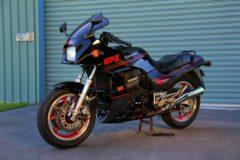Kawasaki has always been the most sporty, or assertive, brand from Japan. The days when the brand had the only approach that it simply wanted to score on speed and dynamics were well over in the first half of the eighties. At the time, Kawasaki not only made fast, but also reliable and well-handling motorcycles. And the Kawasaki GPZ900 R was there and from there.
State of the art
The 'Ninja 900' was a four-cylinder, sixteen-valve fluid cooler, a six-speed gearbox and a lubrication system designed for very long, fast journeys. The engine block was surprisingly compact and had a width of only 451 mm. The distribution chain was on the left side of the block to optimize its accessibility. In terms of speed, the Kawasaki GPZ900 R was also 100% Kawasaki, the four-cylinder was the first standard engine that ran faster than 240 km / h. The GPZ was an instant success on the American drag strips. The engine was globally named 'The Engine of the Year' in various engine magazines.
Despite that sportiness and performance, the Kawasaki GPZ900 R was just a very nice motorcycle
The driver and even the passenger were quite comfortable with it. And if the passenger wasn't that close with the rider, the passenger had a comfortable brace on the back of the buddy to hold on to. The dashboard was very complete with even a tell-tale for the standard (By the way, to bend the engine was quite a job), an eccentric chain tensioner.
Now old school
In fact, the Kawasaki GPZ900 R belonged to the latest generation of sports motorcycles that still looked like a motorcycle and not yet like a guided missile from a Japanese comic. The sitting position is classically stretched. The flat handlebar in front of the long tank, the knees active, but not deadly sharp angled. Very dated, that's the front wheel. In the fashion of the time, that was one of only 16 inches. That front wheel, in combination with the head angle of 24 degrees, made the Kawasaki quite lively. Okay, the gearbox shifted a bit stiffly at low revs, but which Kawa pilot was driving at low revs now? The clutch required a firm hand. And the pure Kawa character showed itself by the spark plugs that often hit fat in city traffic.
But then again: What did a Kawasaki GPZ900 R driver have to do in the city?
All the more so because with such improper use, the block could also get quite warm. The Ninja just had to trot! And that while revolutions were allowed to run, that was the brand's honor. In doing so, it had to be taken into account that the brake discs were only pressed by two pistons per caliper. The discs were perforated for better heat dissipation, but they are now indicative of the dated nature of the design. Just like the anti-dive system on the front fork.
A safe buy
When you buy a Kawasaki GPZ900 R you only have to pay attention to what the machine looks like. The only points of interest are the chain tensioner of the camshaft and the synchronization of the carburetors. Oxidized contacts may cause some electrical problems. It may be necessary to dismantle and clean the fairly complicated anti-diving system.
You already have a GPZ900 R project between the 500-600 e. And then demands may already be made. An absolute topper must not cost more than such an 3500 euro






